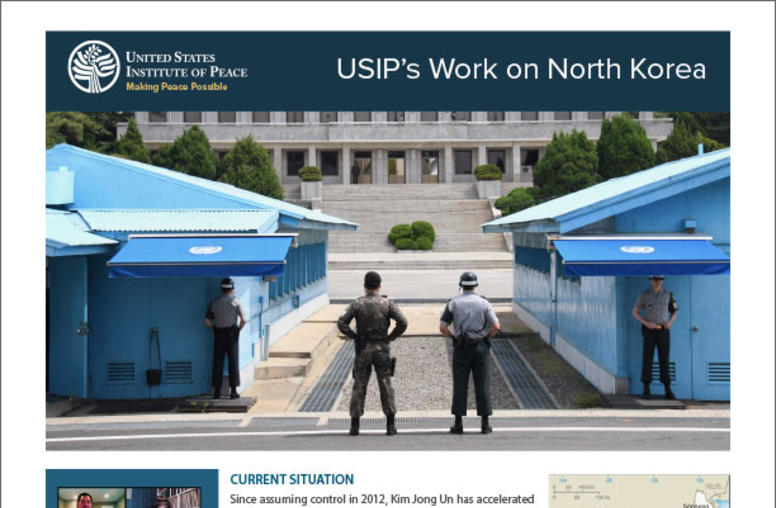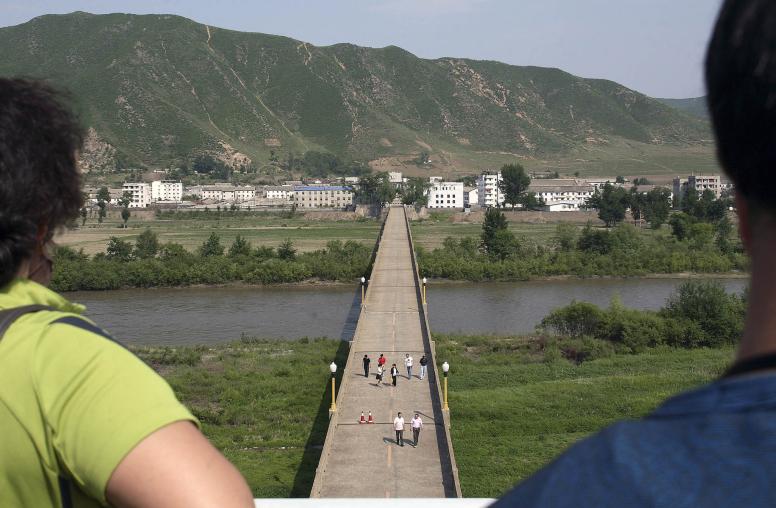It’s Time to Get Real on North Korea
The Biden administration should overhaul America’s outdated strategy and the unrealistic assumptions behind it.
Weeks after North Korean leader Kim Jong Un vowed to dramatically upgrade his nuclear arsenal, the Biden administration is reviewing U.S. policy on North Korea. A reality check is overdue. The Trump administration’s headline-grabbing threats and summits were just new packaging for the decades-old approach of expecting Beijing’s help to pressure Pyongyang to surrender its nuclear program. This failed again, and North Korea’s threatening capabilities grew. The Biden administration should—and can—establish a more pragmatic, realistic policy to urgently counter this threat, shore up stability, avoid war and advance a deeper, longer game of fundamental change in North Korea.

The Trump administration’s “maximum pressure and engagement” policy toward North Korea was not the departure from previous approaches that it may have promised. It turned out to be a dramatic and erratic version of the same basic North Korea strategy that Washington has used for over two decades. This strategy has focused on achieving a “strategic decision” from Pyongyang to negotiate an end to its nuclear weapons program and on securing Beijing’s cooperation to build the necessary economic leverage. As Trump confronted Pyongyang with bombast in 2017 and pivoted to televised summitry in 2018, commentators noted the use of new tactics and Trump’s unprecedented rhetoric while glossing over the policy’s strategic consistencies with preceding administrations. By late 2019, the pretense of “maximum” pressure and the pomp of presidential-level “engagement” disappeared, leading observers to opine that Trump’s policy had come to resemble the Obama administration’s unofficially, often pejoratively, termed “strategic patience.”
Kim Jong Un has made his “strategic decision” clear—to become and remain a nuclear-armed power—despite the costs. This is underscored by his declaration of plans for continued growth in North Korea’s nuclear and missile capabilities. Meanwhile, Chinese leader Xi Jinping has shown repeatedly that Beijing still prioritizes stability on the Korean Peninsula over North Korean denuclearization.
Given these developments, the Biden administration should seek to escape the inertia of its predecessors by crafting a pragmatic new strategy toward North Korea. This should be premised not on Beijing’s cooperation, nor on Kim’s willingness to denuclearize, but rather on how to address the growing risks of a resolutely nuclear-armed North Korea. The new strategy should focus on reducing the risks of regional destabilization, military escalation and nuclear war stemming from North Korea’s growing nuclear and missile capabilities. It should do so by working with allies to shore up deterrence while offering expanded engagement to Pyongyang on issues beyond denuclearization. The strategy should also foster long-term changes in Pyongyang’s domestic and external conditions to fundamentally change its behavior and calculus in ways that could eventually make North-South reconciliation and denuclearization feasible.
An Old Strategy on Weak Foundations
Though Washington’s enduring North Korea strategy has not been contained in a document passed down through administrations, it has remained remarkably consistent from Clinton through Trump. It could be summarized as: “Negotiate an end to North Korea’s nuclear weapons program through diplomatic and economic leverage, while maintaining regional stability and minimizing risk through multilateral diplomacy, military restraint, and extended deterrence guarantees to U.S. allies.” Aside from some vague threats of military force, this strategy primarily relied on economic pressure and incentives as the leverage to achieve denuclearization, though diplomatically isolating or recognizing Pyongyang was also considered essential leverage.
The strategy rested on assumptions that have proven false. The first was that Washington could wield sufficient leverage to override the Kim regime’s desire for nuclear weapons. The second was that Washington could obtain sufficient cooperation from Beijing to persuade Pyongyang to denuclearize. These assumptions, however, were soon at odds with the expert judgments of experienced U.S. diplomats and the American intelligence community. U.S. intelligence assessed early on—starting in a 1991 National Intelligence Council memorandum—that sanctions would not halt North Korea’s nuclear weapons program nor cause Pyongyang to negotiate it away, while Beijing would provide a lifeline to Pyongyang. In the decades since, such assessments have been borne out as far more realistic than the strategic assumptions they contradicted.
Nevertheless, Washington remained trapped by these untenable assumptions, in part because of what discarding them would mean for larger priorities like regional stability, global non-proliferation, and relations with China. If Washington acknowledged that it did not have sufficient leverage to get the Kim regime to negotiate away its nuclear program, it could be seen as accepting North Korea as a nuclear-armed power or presenting military conflict as the only recourse. Either possibility was seen as politically unpalatable and unacceptably risky, particularly while North Korea’s nuclear progress remained limited and hopes for denuclearization diplomacy continued.
The Pragmatism We Need
Given the increasing risks posed by North Korea’s growing nuclear and missile capabilities, it is now past time to accept the lesser risks of a new strategy based on more realistic assumptions: The Biden administration’s North Korea strategy must be designed to deal with a resolutely nuclear-armed North Korea and an uncooperative China.
These new assumptions would shift the new strategy’s focus away from near-term denuclearization. This would allow the U.S.-South Korea alliance to recalibrate its defense posture and military training, which has been constrained and distorted by the old strategy—and its optimistic assumptions—for over two decades. U.S. and allied military activities in and around Korea have been held hostage at times by fruitless denuclearization diplomacy and constrained by Washington’s unwillingness to acknowledge that, despite diplomatic efforts and U.S. restraint, the North’s nuclear and missile threat has been growing dramatically. This latter problem reached a new level in 2019 and 2020, when President Trump repeatedly downplayed North Korean launches of more capable short-range solid-fuel missiles and a new submarine-launched ballistic missile. As deterrence expert Brad Roberts tactfully put it: “efforts to adapt and strengthen deterrence so as to stay ahead of the emerging threat” were “put on the back burner in recent years as a sign of good faith” toward North Korea.
The new strategy should enable concrete political and military steps that shore up deterrence—with a focus on denying North Korea any perceived political or military advantages from improved nuclear and missile capabilities. These steps could include a campaign to noticeably improve the resilience and confidence of the U.S.-South Korea alliance in the face of threatened or actual North Korean nuclear or conventional missile attack. Improvements in training and defense infrastructure to absorb such North Korean strikes and still prevail would be more pragmatic and effective deterrent measures than new rounds of strategic bomber flights or public threats of retaliation. Such measures would reduce the risk that North Korea’s growing capabilities and weapons testing engender miscalculations and adventurism that could lead to nuclear war.
Meanwhile, Washington and Seoul must counter Pyongyang’s effort—supported by Beijing—to portray U.S. military training and deterrent measures as a primary obstacle to engagement and as “forcing” North Korea to respond with provocative behavior. North Korea itself has conducted strategic weapons tests just before planned meetings and expected them to continue, while historical data shows that North Korea can continue diplomacy and restraint in the immediate aftermath of exercises when it chooses to.
The old strategy narrowly constrained more than just military activities for the United States and its allies. Washington restrained its diplomatic contacts and other engagement with Pyongyang, and even tried to restrain Seoul’s engagement at times, to prevent such engagement from “getting out ahead of” progress on denuclearization. Under a new strategy unburdened by unrealistic expectations for near-term progress on denuclearization, the Biden administration could open a range of broader engagement avenues, including those between North and South Korea. It could do so without abandoning principled calls for adherence to U.N. Security Council resolutions that prohibit North Korean ballistic missile and nuclear programs and impose international sanctions to constrain the resources available to these programs.
A Strategy for the ‘Long Game’
U.S. offers for new avenues of engagement, including via military channels, cultural exchanges and diplomatic liaison offices, could all be made openly, regardless of progress on denuclearization. Such efforts would help build buffers against the risks of escalation, misinterpretation, and miscalculation in crises, as well as help combat perceptions of implacable U.S. hostility. Perhaps more importantly, these channels could also help engender longer-term change in North Korean ruling elites’ thinking in ways that could favor U.S. objectives, interests and values.
A broader U.S. approach to engaging North Korea would doubtless be embraced by South Korea’s President Moon. Even if Kim remained reticent and often confrontational, greater openness to engagement would put the onus more clearly on Pyongyang, not Washington, for continued “hostile relations” and North Korean isolation—making it easier to maintain international support for shoring up key elements of sanctions and military deterrence to contain the growing threat.
The old strategy also often led to U.S. caution and inconsistency in influence campaigns, including disseminating information into North Korea and promoting North Koreans’ human rights, because such efforts could be seen as a distraction from getting Pyongyang to the table for denuclearization negotiations. Though a more robust focus on these avenues is unlikely to bear fruit quickly, they offer the prospect to move the needle on the more fundamental changes of governance and priorities inside North Korea. Such domestic changes could someday (probably in a post-Kim Jong Un era) make it more realistic to expect a real breakthrough in diplomatic relations or even a “strategic decision” for denuclearization in exchange for economic transformation and integration into the international community.
Reorienting Washington and its allies to a pragmatic North Korea strategy—one that focuses on mitigating the consequences of North Korea’s nuclear breakout while promoting long-term strategic change—is unlikely to be as politically attractive as rekindling hopes of rapid denuclearization by attempting some new policy twists on negotiations, incentives, sanctions and outreach to Beijing. To mitigate any domestic and international fallout, these overdue adjustments to strategic assumptions could be made without fanfare and without abandoning either coordination with China or the principle of refusing to “accept” North Korea as a nuclear power. Ultimately, a more pragmatic strategy would better serve U.S. interests, particularly given how thin Washington’s prestige, resources and attention will be stretched by a wide range of national security challenges, particularly China.
With consistent effort, the new strategy could blunt North Korea’s challenge to stability and deterrence while leaving allies more confident in U.S. protection, rather than more inclined to pursue their own nuclear weapons. Restraining North Korea’s bellicosity enough to prevent nuclear tests, ballistic missile tests or military aggression would be a goal worth some cost and risk to achieve—less lofty, but more realistic than denuclearization. Without abandoning the “long game” of denuclearization, the new strategy could reduce the risk that a future Korean crisis would either reward North Korean coercion or spiral through miscalculation into a devastating nuclear war.
Markus Garlauskas is a nonresident senior fellow at the Atlantic Council’s Scowcroft Center for Strategy and Security. He served nearly 20 years in the U.S. government dealing with North Korea—most recently as the senior official leading strategic intelligence analysis of North Korea, after serving as chief strategist for U.S. Forces Korea. The views expressed in this publication are the author’s and do not imply endorsement by the Office of the Director of National Intelligence, the U.S. Intelligence Community or any U.S. government agency.



